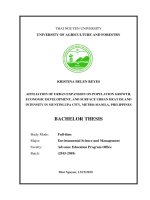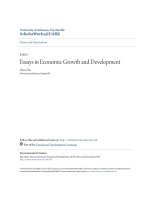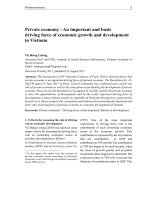Economic growth and economic development 706
Bạn đang xem bản rút gọn của tài liệu. Xem và tải ngay bản đầy đủ của tài liệu tại đây (62.91 KB, 1 trang )
Introduction to Modern Economic Growth
from labor-augmenting technologies and thus encourage further labor-augmenting
technological change. These strong price effects are responsible for the stability of
the constant growth path allocation in Proposition 15.14. Consequently, an elasticity of substitution less than 1 forces the economy to strive towards a balanced
allocation of effective capital and labor units (where “effective” here refers to capital
and labor units augmented with their complementary technologies). Since capital
accumulates at a constant rate, a balanced allocation implies that the productivity
of labor should increase faster, in particular, the economy should converge to an
equilibrium path with purely labor-augmenting technological progress.
The results in Proposition 15.14 are potentially important, since they provide a
justification for the assumption in the Solow and neoclassical growth models that
long-run technological change is purely labor augmenting. Naturally, whether or
not this is the case in practice is an empirical matter and is an interesting topic of
future empirical research.
15.7. Other Applications
Models of directed technological change have a range of other applications. To
save space, these are not discussed in the text and are left as exercises for the
reader. In particular, Exercise 15.20 shows how this model can be used to shed
light on the famous Habakkuk hypothesis in economic history, which relates the
rapid technological progress in 19th-century United States to relative labor scarcity.
Despite the importance of this hypothesis in economic history, there have been no
compelling models of this process. This exercise shows why neoclassical models
may have a difficulty in explaining these patterns and how a model of directed
technological change can account for this phenomenon as long as the elasticity of
substitution is less than 1.
Exercise 15.21 shows the effects of international trade on the direction of technological change. It highlights that international trade will often affect the direction in
which new technologies are developed, and this often works through the price effect
emphasized above.
Exercise 15.27 returns to the discussion of the technological change and unemployment experiences of continental European countries we started with. It shows
692









